| 1 | Found in ponds, streams and wetlands |
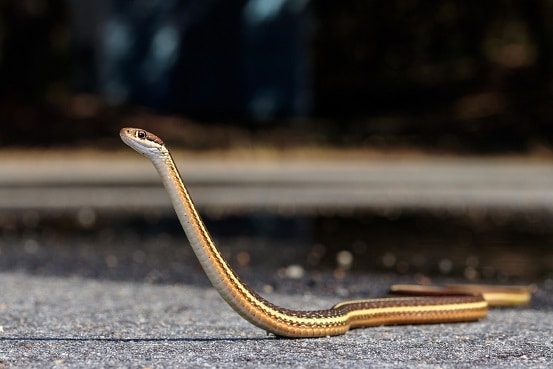
The eastern ribbon snake is a very common US species, which is yet another member of the wide garter snake (Thamnophis) family. It closely resembles the common garter snake (Thamnophis sirtalis), but is a completely different species, separated by millions of years of evolution.
The common garter snake can live in woods, fields, streams, and people’s gardens, where they helpfully slurp up slugs and caterpillars. The ribbon snake, meanwhile, sticks to watery areas far more strictly. It’s a species not of wide rivers, but of ponds, small streams, shrubby wetlands, and shallow lakes. The ribbon snake can inhabit flowing water bodies, but as a rule, they prefer standing or slow-moving ones. Thick vegetation on the shores of streams and marshes are their favourite places to relax, the ribbon snake equivalent of a sofa and TV. They’re often found near beaver hangouts, including where dam builders are clearly at work.
The eastern ribbon snake is a separate species from the western ribbon snake (Thamnophis proximus), and ranges from New York in the north to Florida in the south. There’s also a sizeable colony in Ontario, Canada.
| 2 | Timid, but fast and nimble |
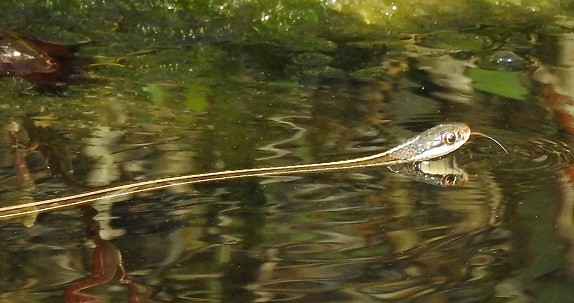
Spotting a ribbon snake is easy if you live in the countryside, as heading to your local stream or pond after rainfall will work like a charm. The ribbon snake is active by day, and therefore easiest to spot by day. This is a non-venomous snake that poses no risk to summer picnic-ers.
Ribbon snakes are a fast and nimble species. They’re timid, and very quick to jump into water and flee if disturbed, by a photographer or maybe a scientist. They don’t stick to a narrow home area like some water-loving snakes. One study found a mean movement of 145 metres over 42 days, and one male moved 1050 metres over 7 months.
Ribbon snakes are also excellent climbers, and can climb 6 metres up a pondside tree, or 2 metres up into tangled bushes. Ribbon snakes have the natural instinct to flee up these trees during flooding events, reaching a cosy point of safety as the riverbank rises. From May to September, they stick to their watery realms closely, as it’s rare for a ribbon snake to move further than 6 metres onto dry land during summer. In October, they sometimes move 150 metres from the shore, into wet fields adjacent to them.
| 3 | Comparison: common garter snake |
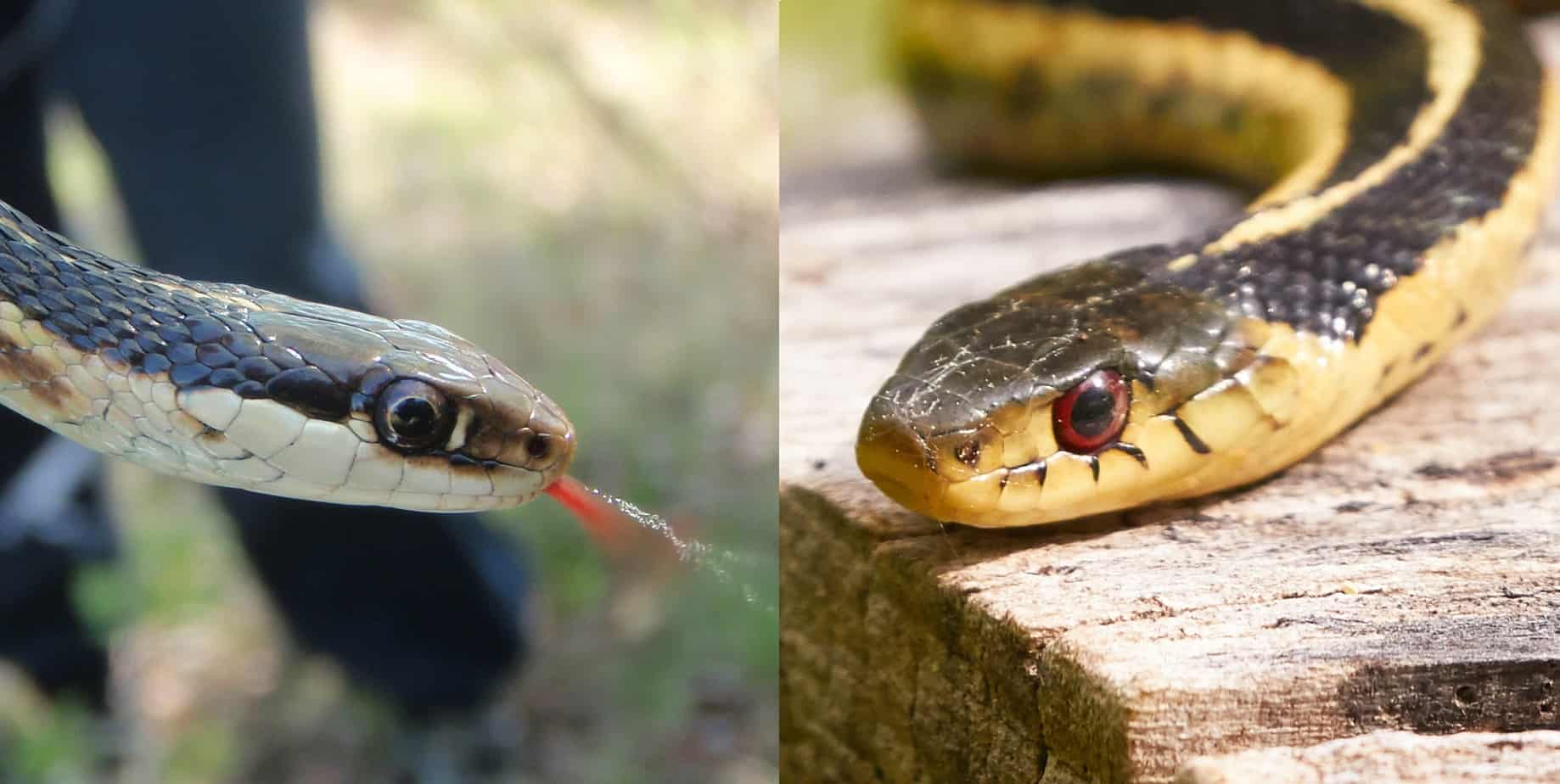
The common garter snake has at least 15 subspecies. The eastern ribbon snake sits alongside the plains garter snake or Butler garter snake: a fully separate species, yet part of the same family, and very similar looking to a layman.
The top difference is that ribbon snakes are significantly thinner than garter snakes. In fact, they’re the thinnest member of the entire Thamnophis family. Both head and body are sleeker. Ribbon snakes also have two telltale white dots in front of the eye, which the garter snake totally lacks. Length isn’t much of a key, as both can be 50 to 100cm. Ribbon snakes are slightly shorter.
The face is the strongest sign, as the ribbon snake has a strongly bi-coloured head. Both species have a darker back, contrasting against a creamy belly, a separation which extends through the face. But garter snakes have a series of vertical black lines below their lips, creating a messier look. On a ribbon snake’s face, there are no such stripes; the separation is far neater. Additionally, the lighter sections themselves are usually paler than the garter snake’s, almost white rather than creamy.
| 4 | Detaches its own tail |
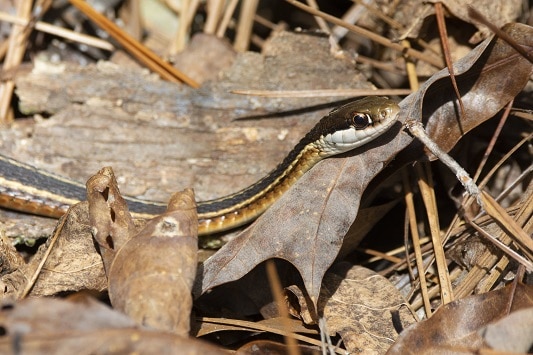
Unlike the queen snake, the ribbon snake is unable to dive below the surface and hide for 30 minutes. They’re forced to swim rapidly along the shore and hide in thick vegetation instead. They’re a slightly less adapted water snake than some of their neighbours. But ribbon snakes have their own neat trick – detaching their tail.
If picked up by a bird or curious human, a panicking ribbon snake can use a last resort weapon and slough off a major body, in an epic and desperate sacrifice. The tail will still twitch when separated, fooling birds into thinking it’s alive and worth scavenging, allowing the snake itself to escape. These tail wounds seal extremely quickly, with minimal bleeding.
The ribbon snake has special weaknesses in the lower vertebrae to allow it to snap off easily. The tail doesn’t grow back (no snake’s can), and one study found that young ribbon snakes with detached tails were rarely recaptured, giving them a poor life expectancy. However, another study found that garter snakes with 2/3 of their tails missing were only slowed down by 4.5%. If the trick survived this long, then evolution must have deemed it worthy.
| 5 | Shifts heat around its body |

The ribbon snake has another tail trick up its sleeve as well. Like the common garter snake (which almost reaches Alaska), ribbon snakes are more cold adapted than other snakes. One of their tricks is to deliberately shift warmth from their tails to their bodies, where it’s more useful. The achieve this by controlling blood flow.
A study found that in spring, a ribbon snake’s tail was far colder than its body. Being a thin snake, they calculated that a ribbon snake’s tail had a 1.7/1 surface to air ratio, allowing greater quantities of heat to escape. The ratio for their body was 1.1. The final evidence for this trick was that during summer, the tail and head showed no temperature difference. The ribbon snakes were clearly controlling it on purpose. In spring, the average body-tail temperature difference was 2.28C, and occasionally up to 7C, while in summer, the difference was only 0.36C.
On a crisp April morning in New York, when frost could easily sweep back in, ribbon snakes need to preserve all the heat they can. Cottonmouths haven’t discovered this trick yet and that’s why they’re stuck in their Louisiana swamps.
| 6 | Avoids the deepest waters |
They may be water lovers, but ribbon snakes are unable to cope with deep water bodies. When fleeing in large lakes or flowing rivers, they rarely travel directly across, skirting around the edges instead. In shallow streams or ponds, meanwhile, they’ll swim directly to the opposite shore. The queen snake and northern watersnake are superior at coping with strong currents.
Yet another of their tail tricks is waggling it to distract attention from their heads. The fast-moving eastern ribbon snake can bewilder its enemies with sudden directional changes, and although they almost never bite, they can make bluff strikes. They have the power to release a foul smelling musk, said to have a sickeningly sweet smell.
The ribbon snake can also fake its own death, part of an illustrious club. Unlike western hognose snakes, ribbon snakes don’t open their mouths and loll their tongues out lifeless; they normally kept them closed. However, they’re unusual in that their body goes completely rigid, like rigor mortis. The ribbon snake can play dead for 5 minutes before reactivating.
| 7 | Diet: over 90% amphibians |
It’s all about amphibians for the ribbon snake. This cold-blooded creature has a cold-blooded diet, and not because it savagely swallows its prey with no remorse. Unlike the rat-loving gopher snake, the ribbon snake eats no mammals at all, and no reptiles.
A 1952 study on 557 Michigan ribbon snakes found a diet consisting of over 90% amphibians. The prey was mostly frogs, based on the ribbon snake’s size. Small ones were fond of the southern chorus frog and spring peeper (Pseudacris crucifer), named because its calls mark the start of spring. Larger ribbon snakes ate green frogs, northern leopard frogs, wood frogs, and pickerel frogs. The study also found two caterpillars and two fish.
A more recent study on 21 ribbon snakes from Michigan and New York found that amphibians were not 90%, but 100% of their prey. By far the most common species was the northern leopard frog (Rana pipiens), named for its patterns. They also ate newts, pickerel frogs, and a small American toad. This study had a smaller sample size, so the true figure is likely 90-95% amphibians. Ribbon snakes also scavenge corpses occasionally, including dead fish.
| 8 | A clumsy hunter |
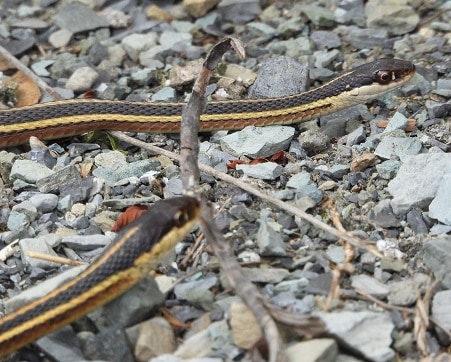
The ribbon snake is a catch and grab snake. They swim around with their mouths wide open, hoping to latch onto something. If a frog lands in the jaws of death, the ribbon snake’s mouth will instantly close. There’s no venom or constriction, and the ribbon snake swallows the amphibian down, almost always legs first (which is unusual for snakes). This may be one of the more incompetent snakes, as one ribbon snake spent 45 minutes chasing frogs around the edge of a pool, and made eight failed grabs.
Eastern ribbon snakes are oviviparous, laying live young, ranging from 2-26. In winter, they hibernate in dens below the surface, with the all-consuming quest to avoid the frost. They sometimes coexist when hibernating, with a dozen crammed into a single den. In the mad rush for position, finishing last can sometimes result in death. Scientists found 11 eastern ribbon snakes crammed into an old ant mound one year, and the one highest up was frozen solid.
Meadow vole tunnels are also popular, as are the root channels of fallen trees. However, scientists failed to find any hibernating in crayfish burrows, which are the bread and butter of the Kirtland’s snake.
| 9 | The electric blue subspecies |
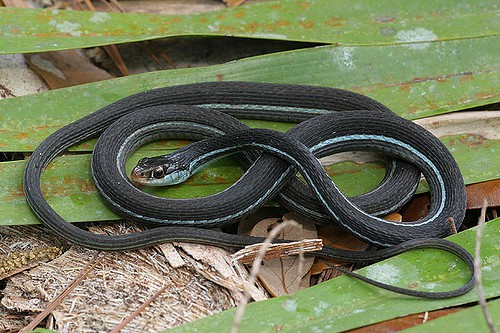
The two ribbon snake species are the eastern and western, and within the eastern ribbon snake (Thamnophis saurilus), there are 4 subspecies. Confusingly, the main one is just called the eastern ribbon snake (T. s. saurilus). Around New York and Michigan, there’s the northern ribbon snake, while in Florida you can find the peninsular ribbon snake (T. s. sackenii). The differences are minor, but the most stunning subspecies is the vivid blue-striped ribbon snake (T. s. nitae).
This occupies just a small stretch of the gulf coast in northwest Florida. They live in the same ponds, streams and lakes, and they eat the same amphibian-based diet (there’s probably regional specialities which we haven’t discovered). However, their pale stripes are not white, but a turquoise blue, with the dark scales on each side a car tyre black. The colour is like a 2 minute Microsoft Paint job with someone using the fill option to replace white with blue.
Additionally, the middle stripe running down its spine is often missing, or more weakly defined, while its tail is even longer than the main eastern ribbon snake. The bluestripe ribbon snake resides from Wakulla county southwards to Hernando county.
| 10 | Rarely strays far from water |
One of Virginia’s most snake-infested spots is Mason Neck National Park, home to at least 16 species. There’s copperheads, eastern racers, and hognose snakes aplenty, and it’s a spot where the common garter snake and its relative the eastern ribbon snake live side by side.
A 2016 study revealed how they differ, as the eastern ribbon snake spent 96% of its time in brush near ponds. The remainder was spent in old fields. Meanwhile, the garter snakes were found in ponds 40% of the time, but old farmsteads 42% of the time, fields 7% and woods 9%.
They also compared diet. The common garter snake ate far more toads, including American toads and Fowler’s toads, and larger frogs like American bullfrogs. They also ate a few lizards and rodents. The ribbon snake relied on smaller frogs, including American green treefrogs, northern cricketfrogs, spring peepers, and upland Chorus frogs. The two relatives were able to co-exist by sticking to their own specialities.
